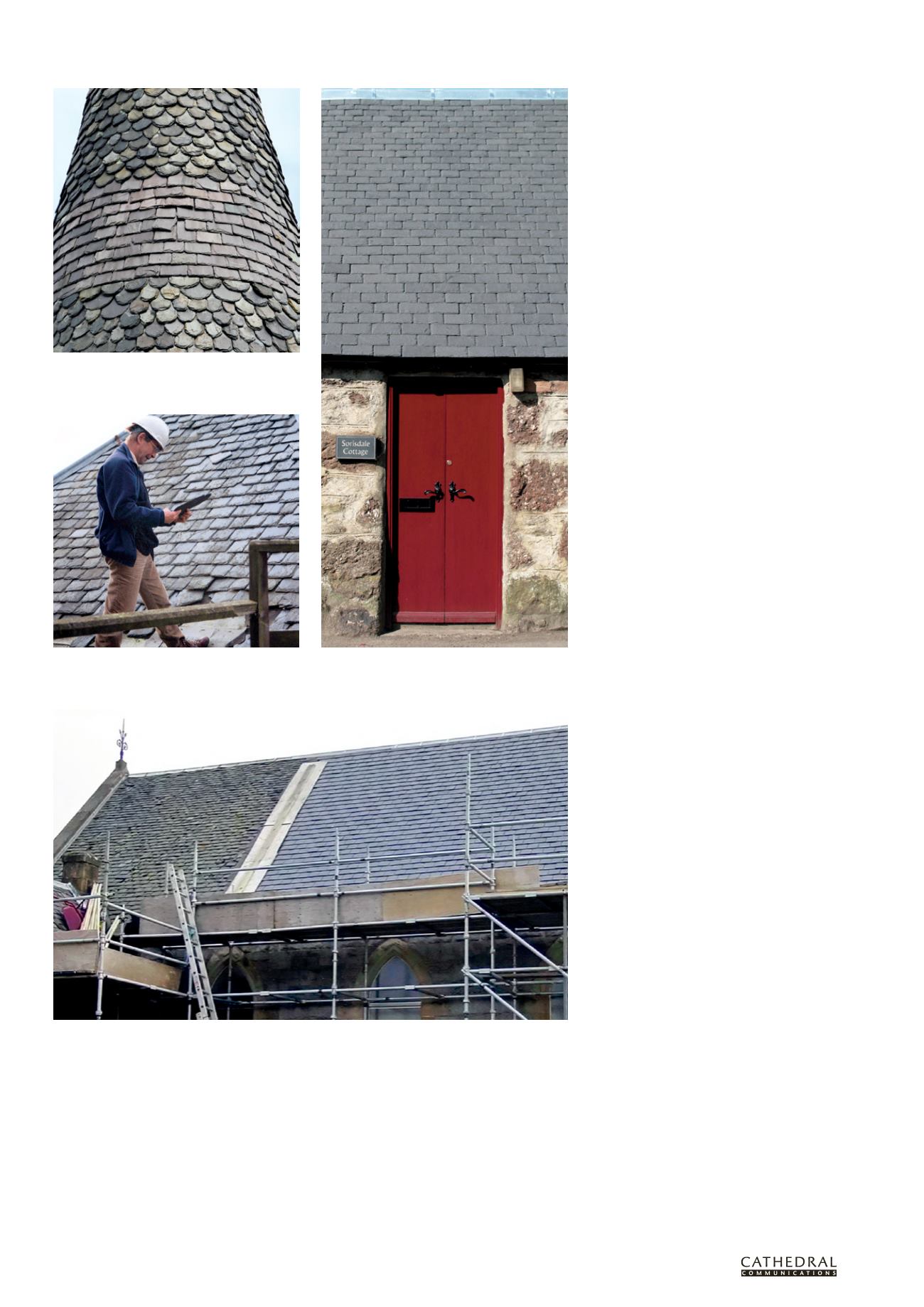

8 2
T H E B U I L D I N G C O N S E R VAT I O N D I R E C T O R Y 2 0 1 5
T W E N T Y S E C O N D E D I T I O N
3.1
STRUCTURE & FABR I C :
ROOF I NG
a flashing has becoming loose or misaligned,
repairs should be carried out as soon as
possible. Flashing defects can allow significant
amounts of water to penetrate into the fabric
leading to decay of timber and a build-up of
moisture in masonry. An inspection internally
of the underside of the roof will also show
whether there is any water ingress and aid the
identification of problems which may not be
obvious externally.
SOURCING SLATE FOR REPAIR WORK
As no Scottish slate has been produced for
over 50 years, sourcing suitable replacements
for use in repair work can be challenging.
While salvaged or reclaimed Scottish slate
may be available in some instances it is likely
that new slate will be required for many jobs
due to the scarcity and cost of reclaimed
material. When procuring new slate, care
should be taken to match as far as possible the
dimensions, thickness, texture and colour of
the original slates (Figures 5 and 6). It is also
important to replicate the original pattern
as far as possible, using the same number of
courses, sidelap and treatment to elements
such as skews and dormers.
Several producers offer a range of sizes to
allow the replication of a Scottish slate roof
with its characteristic diminishing courses.
However, mechanised production means that
the range will not be a full mixture of random
widths and lengths.
SMALL SCALE REPAIRS TO SLATE ROOFS
Roof access and forming a working
platform should be considered carefully
to ensure the safety of the operative and
to avoid damaging adjacent slates. The
replacement of single slates in a Scottish
slate roof is a relatively easy task as they
are normally single nailed (Figure 8). The
broken off head of the slate is removed with
a slate ripper (Figure 9) and a new slate is
dressed to size and nailed in its place.
The issues outlined above regarding
the sourcing of slate for repair work are as
relevant for small patch repairs as for larger
scale re-slating work.
RE-SLATING SCOTTISH ROOFS
Assessing whether a slate roof needs
repair or complete replacement has to be
made based on the amount of repair, the
condition of the slates and other plans for
the building. In some cases the existing
sarking boards may be in sufficiently
good condition to allow the new slates to
be fastened onto the existing boards.
If the sarking boards are damaged and
require renewal they should be re-laid with a
small gap to allow for ventilation. The use of
bituminous under-slate felt or other vapour
barriers under the slates which prevent water
vapour movement can lead to high humidity
in the roof space and can have detrimental
effects on the roof in the long term. If a
membrane or vapour control layer is being
specified it should be of a type which allows
moisture to move through the sarking board
(Figure 10). Modern proprietary roofing
papers are designed for this purpose, and
if correctly specified remove the need for
obtrusive roof vents on the pitches.
In Scottish practice, slates are double
lapped so that each slate covers part of the
slates in two courses below (Figure 8). The
head and side lap must always be large enough
to prevent wind driven rain penetrating
underneath the slate. The head lap or ‘cover’
is the distance by which the leading (bottom)
edge of a slate overlaps the nail hole of the slate
two courses below and is usually 50–75mm,
slate can also take place around the nail hole.
As a general rule, if more than 25 per cent of
the slates on a roof are loose or defective then
re-slating will be required (Figure 7).
When considering repairs, adjacent areas
and elements should be investigated, including
lead flashings, lead valleys and related details
as well as masonry work, chimneys and skew
copes (the coping stones that cap a pitched
gable parapet). If there are external signs that
Figure 3 Scottish slate has decorative as well as
functional applications, as the treatment of this
turret illustrates.
Figure 6 In this case a good match has not been achieved.
Figure 5 New slate should match the characteristics
of Scottish slating practice as shown on this new roof
with its distinctive diminishing courses.
(Photo: WC Cameron Slaters)
Figure 4 A detailed inspection is key to correct
specification of repairs
















